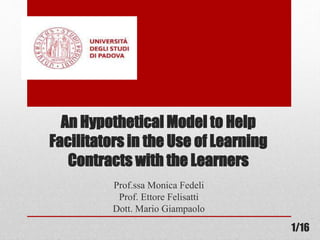Commission of International Adult Education 2013 Lexington
- 1. An Hypothetical Model to Help Facilitators in the Use of Learning Contracts with the Learners Prof.ssa Monica Fedeli Prof. Ettore Felisatti Dott. Mario Giampaolo 1/16
- 2. Why facilitators need to use Learning Contracts in the Italian University setting? 2007-08 2008-09 2009-10 2010-11 2011-12 2012-13 BACHELOR DEGREE PROGRAM 2.830 2.598 2.373 2.239 2.100 2.062 MASTER DEGREE PROGRAM 2.416 2.353 2.205 2.089 1.990 1.962 MASTER DEGREE (4- 5 years) PROGRAM 273 275 278 293 291 300 TOTAL 5.519 5.226 4.856 4.621 4.381 4.324 CHANGING IN THE NUMBER OF PROGRAM DEGREES ACTIVATED 2/16
- 3. Why facilitators need to use Learning Contracts in the Italian University setting? CHANGING IN THE NUMBER OF PROGRAM DEGREES ACTIVATED Totalnumberofprogramdegreesactivated 3/16
- 4. Why facilitators need to use Learning Contracts in the Italian University setting? RELATION BETWEEN THE NUMBER OF STUDENTS FOR EACH FACULTY MEMBER 4/16
- 5. Autonomy Active role Responsibility The learning contract Since 2011 we are engaged with the mission of introducing in our courses the Malcolm S. Knowles’ model of learning contract 5/16
- 6. Personalization extra-curricular experiences, internships, and competencies that need to be developed. (Waldeck, 2006) diagnosis and assessment experiences (Waldeck, 2006) personal involvement and extra class communication (Keefe & Jenkis, 2002; Waldeck, 2006) Learning contract different learning experiences and establish competencies to develop diagnosis and assessment experiences. personal involvement, communication and interaction with students REQUIRES ALLOWS 6/16
- 7. Participants SOCIOGRAPHIC DIMENSION Total number: 18 M: 3 F: 15 Age range between 23 and 48 years An average of 35.5. years EDUCATIONAL BACKGROUND Master degree 27% Bachelor degree 64% No response 9% PROFESSIONAL BACKGROUND Teachers 18% Teachers of adult 18% Social worker 27% Other works/no response 37% 7/16
- 8. Procedure 1) PRESENTATION How to: Meeting face to face /video lecture In deeper understanding using on-line resources on LC Continuous support through a direct line with professor or supervisor 2) NEGOTIATION AND CREATION How to: Creation of the LC Negotiation with professor or supervisor Discussion with peer 3) NARRATION How to: Questionnaire Qualitative and quantitative analysis of students' opinions Quantitative analysis of interactions 8/16
- 9. Understanding LC • STUDENTS’ OPINIONS ABOUT THE PRESENTATION PHASE Examples • Initially I did not understand and was not aware of the instrument… • At the beginning I was floored because what to do was not clear… • The first impression was not very positive.... • My initial impressions have not been very positive for me .. • Initially I could not understand the meaning and usefulness of the LC 9/16 Words that denote difficulty misunderstanding uselessness
- 10. Presentation phase Theory • Understanding Practice • face to face / video lecture • E-learning platform • Group activities 10/16
- 11. Reflecting LC • STUDENTS’ OPINIONS ABOUT THE CREATION/NEGOTIATION PHASE Examples • My impressions were positive, particularly in the negotiation phase, where [it] is possible to express thoughts and reflections. • The discussion in the classroom and in-group, have been the key to calibrate our goals. I reassessed the objective in the light of advice from colleagues and teachers. 0% 0% 24% 76% The LC allows to reflect on your learning in agreement strongly in agreement 11/16
- 12. 41% 59% The LC allows to organize your learning in agreement strongly in agreement 47% 53% The LC helps to fit the contents of the course with your interests in agreement strongly in agreement 6% 35% 59% The LC allows an evaluation of your learning not in agreement in agreement strongly in agreement 12/16
- 13. Theory • Reflection Practice • E-learning platform • Group activities • Discussion forum and direct line Creation/Negotiation phase 13/16
- 14. Narration Phase Theory • Trasformation Practice • Qualitative and Quantitative analysis 14/16
- 15. Our Research Family Tree J. A. Henschke Monica Ettore Mario Joellen M. S. Knowles M. Boucouvalas 15/16 Susan
- 16. Do you want to join the family ? monica.fedeli@unipd.it ettore.felisatti@unipd.it mario.giampaolo@studenti.unipd.it An Hypothetical Model to Help Facilitators in the Use of Learning Contracts with the Learners 16/16











![Reflecting LC
• STUDENTS’ OPINIONS ABOUT
THE CREATION/NEGOTIATION
PHASE
Examples
• My impressions were
positive, particularly in the
negotiation phase, where
[it] is possible to express
thoughts and reflections.
• The discussion in the
classroom and in-group,
have been the key to
calibrate our goals. I
reassessed the objective in
the light of advice from
colleagues and teachers.
0% 0%
24%
76%
The LC allows to reflect on
your learning
in agreement strongly in agreement
11/16](https://image.slidesharecdn.com/anhypotheticalmodelciaepresentation-140519075716-phpapp02/85/Commission-of-International-Adult-Education-2013-Lexington-11-320.jpg)




